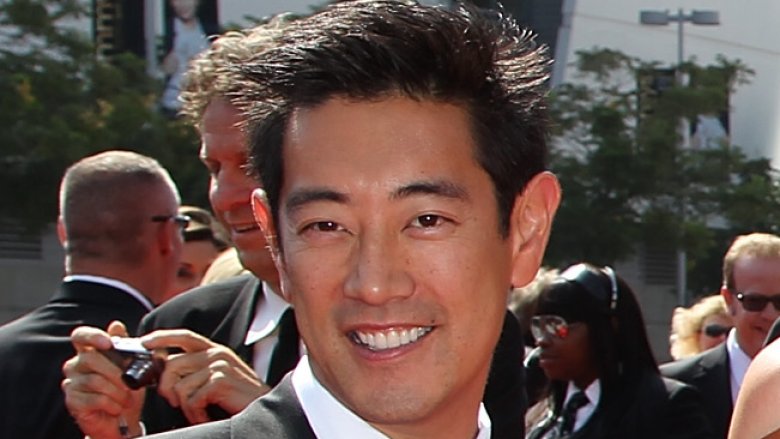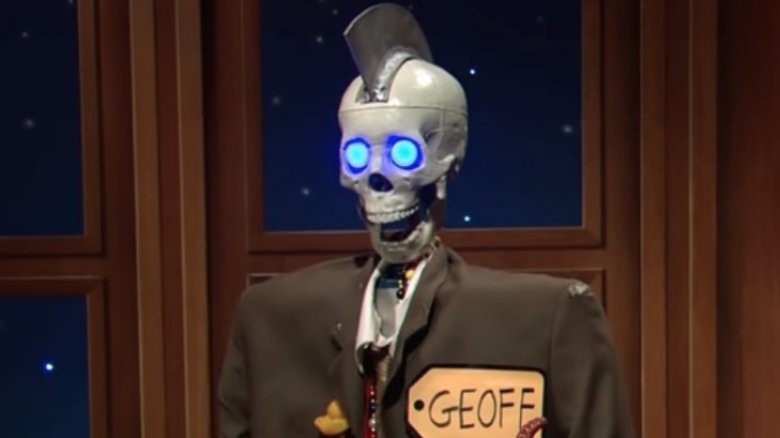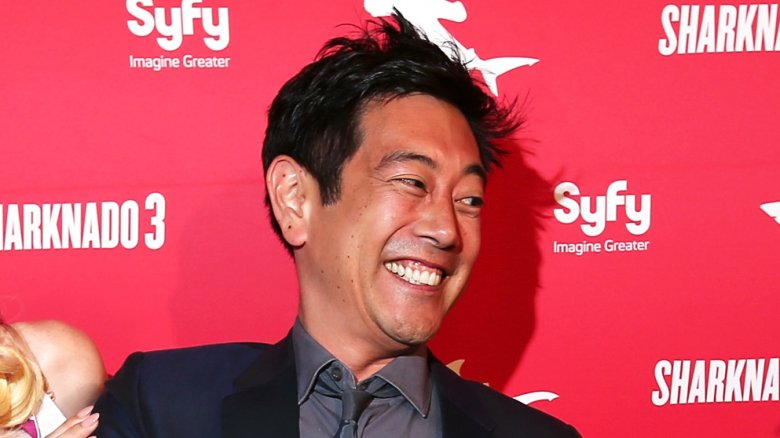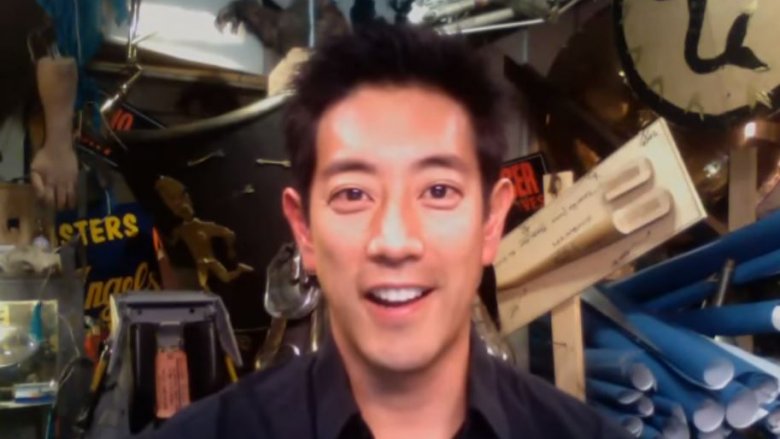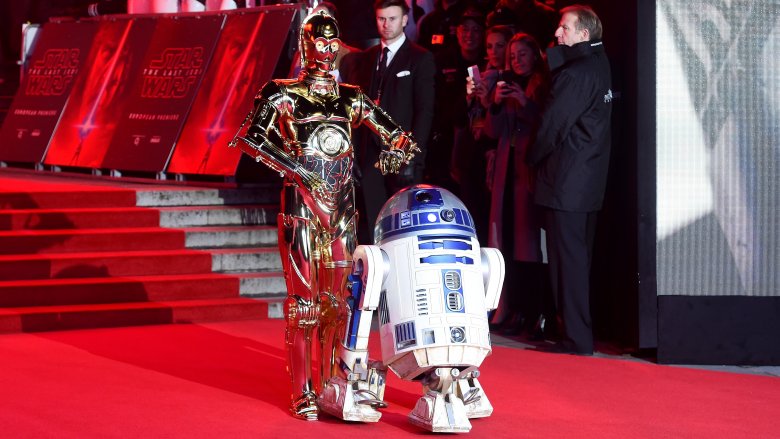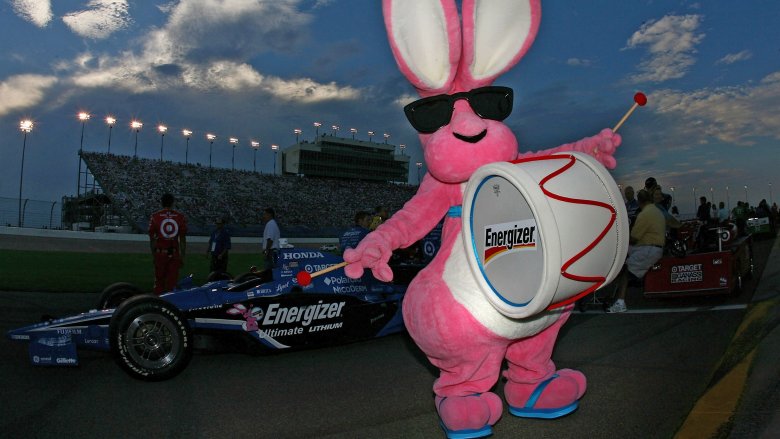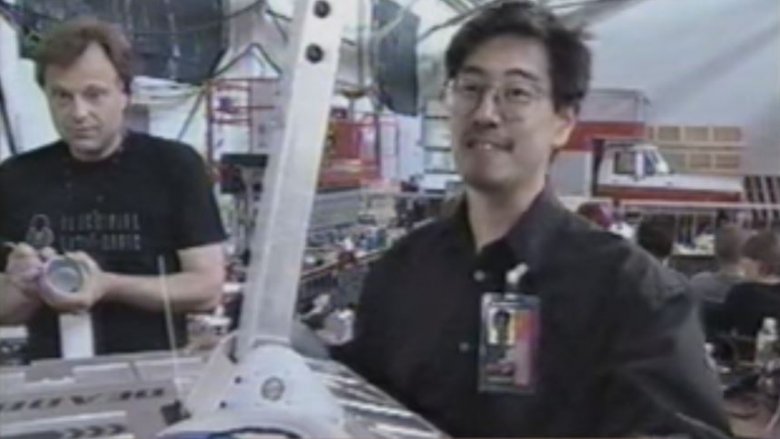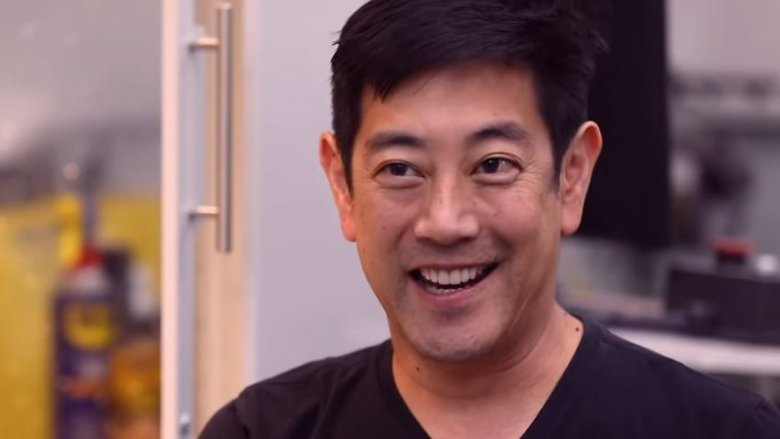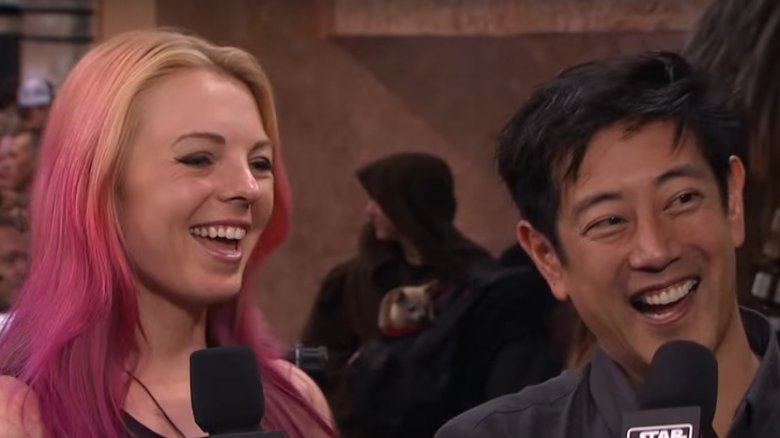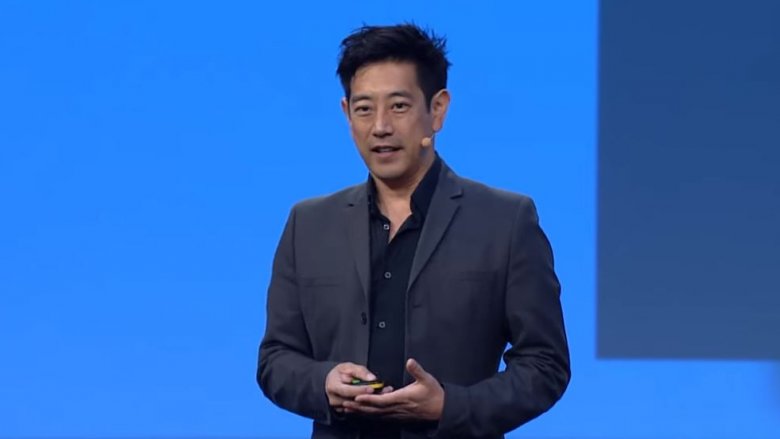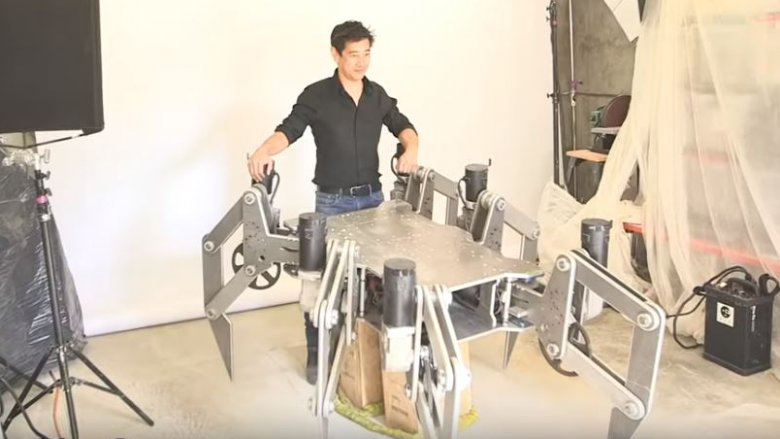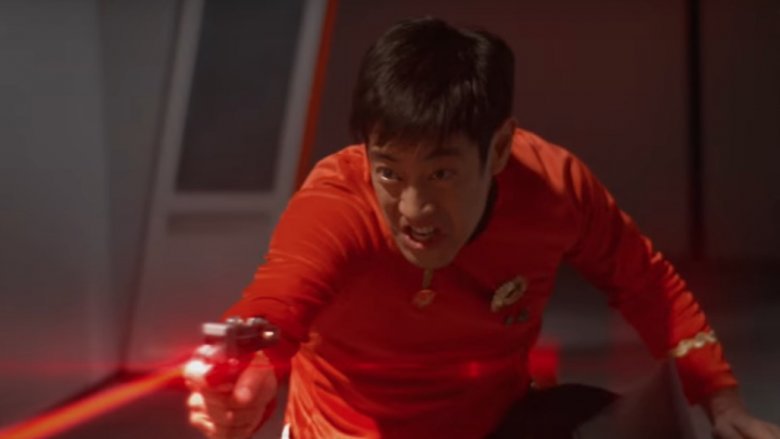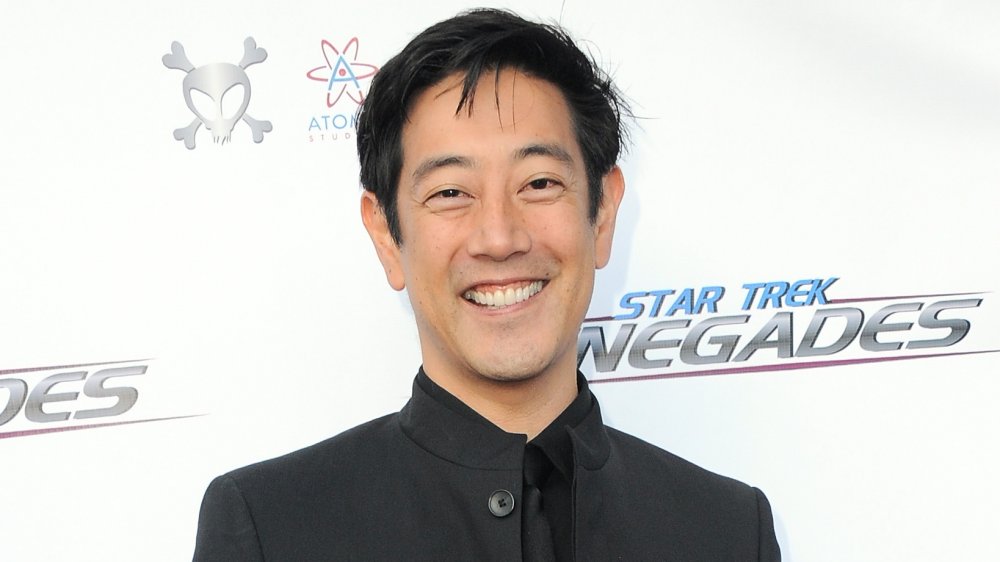The Untold Truth Of Grant Imahara From Mythbusters
Out of all hosts of the MythBusters Build Team, Grant Imahara was arguably the most capable at actually building stuff. At home with machines and explosions alike, the electronics specialist seemed at times to be an entire special effects company mounted on two legs ... which is saying something in a show where all of his peers were effects wizards themselves.
At a glance, Imahara might've seemed less excitable and gung-ho than his Build Team colleagues, Kari Byron and Tory Belleci, but don't think for a second this meant he was taking the back seat for the two. As it turned out, Imahara boasted a CV of scientific and movie industry awesomeness that could stand toe-to-toe with any other MythBuster — yes, including the main duo of Jamie Hyneman and Adam Savage. In fact, as Wired notes, he was the only MythBuster who actually had a technical degree. And the degree is just the beginning, because what Imahara did with it (and a lifetime of work and training) would put even the most dedicated geek to shame. Let's take a look at all the amazing things he did and how he did them. This is the untold truth of Grant Imahara from MythBusters.
Grant Imahara built Craig Ferguson's skeleton sidekick
It takes a special kind of person to casually promise to build a piece of TV history on Twitter, and then follow through on that promise. According to Entertainment Weekly, Grant Imahara did precisely that in 2010 after noticing that Craig Ferguson, host of the Late Late Show with Craig Ferguson, had taken to calling his Twitter followers the "robot skeleton army." Imahara offered to build Ferguson a robot skeleton co-host of his own if the talk show host managed to drive Imahara's Twitter followers over the magic line of 100,000, a task Ferguson soon completed. As Popular Mechanics tells us, Imahara found his part of the deal considerably more difficult to deliver. He tinkered with the robot while shooting MythBusters, which meant precious little time for sleep and a huge rush to get everything ready in time. Only week before the deadline, he still hadn't written the "software that would make [the robot] move."
Despite his struggles, Imahara managed to deliver. The end result was Geoff Peterson, a snarky, remote-controlled skeleton that became so popular it has its own Wikipedia entry (which is, ironically, lengthier than Imahara's own). Ferguson loved Geoff Peterson so much that when the show ended, Imahara announced on Twitter that the talk show host had given the robot a new home in his personal office.
Grant Imahara almost became a screenwriter
Once you saw his genuine love of building things in MythBusters, it was difficult to imagine Grant Imahara not doing what he clearly did best. However, according to the USC Alumni Association, he was once heading in a dramatically different direction. During his sophomore year at the University of Southern California, Imahara lost his love for engineering studies and ended up dropping his classes because he simply couldn't see a way to find excitement in an engineering career. This might seem hilarious in hindsight, but back then, it bothered him so much that he even thought up a backup plan: He'd switch majors entirely and embark on a new quest to become a screenwriter.
Unfortunately for young Imahara (but fortunately for MythBusters fans and the field of engineering), he promptly discovered that the USC School of Cinematic Arts is "highly exclusive," and as such, he couldn't just waltz in. After some soul-searching, Imahara resumed his studies and eventually got his engineering degree ... which, ironically, would go on to make him far more famous than a career in screenwriting probably would have. Then again, who knows? Maybe famed screenwriter Grant Masaru Imahara is right now on his way to collect his fourth Academy Award for the Best Original Screenplay in some alternate universe.
Grant Imahara and Tomlinson Holman
The name Tomlinson Holman might not mean much to you unless you're an audio buff, but for Grant Imahara, it meant the world. As the USC Alumni Association tells us, Imahara was struggling with his passion for engineering studies when a counselor told him to meet with Holman, who was a professor of cinematic arts ... and also the man who developed the revolutionary THX (Tomlinson Holman eXperiment) sound system of Lucasfilm fame. Yeah, turns out he's a pretty big deal.
Whatever that counselor was paid, they certainly earned it that day. Imahara was completely starstruck and offered his services as Holman's unpaid personal assistant. Holman accepted, and Imahara spent an extremely eye-opening year working for him. One thing just kept leading to another. First, Holman's work at THX renewed Imahara's passion for engineering by showing more creative ways to apply his talents. Then, Holman scored the young man an internship at the company, which turned into a full-time job after Imahara had finished his studies. And finally, after three years with THX, Imahara got an even more alluring job with another fairly well-known Lucasfilm company: Industrial Light & Magic.
His work at Industrial Light & Magic
According to his profile at the USC Alumni Association, Grant Imahara spent no less than nine years working at the illustrious Industrial Light & Magic special effects company. During that time, he "lived the sci-fi fanatic's dream," as he got to work on some of the most fantastic franchises you can imagine. Apart from his wide-ranging work with the Star Wars prequels, Imahara also built models for The Matrix Reloaded and The Matrix Revolutions. As if that wasn't enough to sate the dreams of even the biggest nerd, Mouser notes he also got to work behind the scenes on movies such as The Lost World: Jurassic Park, Terminator 3: Rise of the Machines, Galaxy Quest, AI: Artificial Intelligence, and, uh, Van Helsing. Hey, they can't all be winners.
Still, as they say, it's not so much about the journey as it is about the friends you make along the way. During his time with Industrial Light & Magic, Imahara got to know two other ambitious model makers, Tory Belleci and Adam Savage. It's probably safe to say this didn't hurt when he joined MythBusters in 2015.
He was an official R2-D2 operator and an unofficial C-3PO
Grant Imahara isn't the only MythBuster to have worked on the Star Wars franchise. As Tested tells us, both Adam Savage and Tory Belleci have built models for the movies. However, Imahara's contribution was arguably the coolest, as he worked on none other than the beloved R2-D2 droid unit. According to Mouser, Imahara is the guy who brought R2-D2's inner workings up to date for Star Wars Episode I and II. From speed controls to radio gear, he replaced the various R2-D2 units' inner workings with modern technology. The most visible of his changes was the new system he designed for the droid's light displays. He removed the old "rotating color wheel" lit with halogen light, and replaced it with a custom LED rig that, strangely enough, was not built for this purpose. It was actually a repurposed gadget from the main engines of the Protector, the spaceship from Galaxy Quest.
Imahara's time working with R2-D2 came with a particularly neat perk, as it meant he was one of the "three official R2-D2 operators in the United States." It's hard to imagine a greater line for your CV. Oh, wait, here's one. According to Wired, Imahara spent a decade as something of an official backup C-3PO, wearing the golden suit for assorted appearances. In this role, he got to meet Carrie Fisher on the red carpet, and he even appeared on Oprah. Hold on, doesn't this technically mean that C-3PO built R2-D2?
Grant Imahara and the Energizer Bunny
Yes, Grant Imahara was behind the Energizer Bunny. In fact, he was the supervisor for the team behind the character. According to AL.com, Imahara entered the Bunny picture when the battery company fell out with the original builders of the mascot and needed to find someone to build new bunnies. Mouser tells us that Imahara personally built the circuit that enables the Bunny's famous ear movements and beating arms. He's also the guy who installed and programmed all the electronics for the bunnies during his tenure with the project. Somehow, his relationship with the Energizer Bunny didn't even end with assorted gadgetry. He also took his creature into the field in the role of "the Bunny's driver and crew supervisor" in commercials shot all around the world.
Imahara shared some of the secrets of the mascot. Despite seeming quite small, the Bunny is actually roughly 2 feet tall because it's filled to the brim with electronics. It actually takes a whopping 44 AA batteries to get them working (Imahara assures us they're all Energizers), and there's a team of three people just to keep the arms operating like they're supposed to. Imahara's crew built three bunnies — named Earl, Floyd and Garth — and while he doesn't say precisely how much they cost, he does hint that each one is roughly as expensive as a Ferrari.
Grant Imahara's battle robot
Much has been made of Adam Savage and Jamie Hyneman's ultra-destructive BattleBots robot, Blendo, but Grant Imahara was also an esteemed veteran of the robot combat arena. As Makezine tells us, his foray into the BattleBots world was called Deadblow, and it was a sleek, middleweight thing armed with a powerful pneumatic hammer. And the robot's tenure on the show was a highly successful one. It was victorious in two "Middleweight Rumbles" and was even ranked as the number one robot in season three. Success in robot combat came with a few extra perks, too. Deadblow was such a popular contestant that it inspired several toys, and the experience even scored Imahara a book deal.
Imahara reminisced about his time on BattleBots with fondness. He said that although maintaining Deadblow was both time and money intensive, he loved the thrill of putting his innovations up against talented opponents. He even likened the BattleBots experience to a "cool party," and since Deadblow's website tells us that its crew included people like Jon Foreman (who worked on the models of U.S.S. Enterprise and the Back to the Future DeLorean), Bryan Dewe (the guy who created RoboCop's thigh gun holster), Adam Savage, and Jamie Hyneman (but of course), it's hard to argue with that metaphor.
Imahara wrote the definitive book on building combat robots
Grant Imahara was a noted builder of robots and tinkerer of electronics, but did you know just how respected he was when it came to murderous machines? As it turns out, this guy has written the definitive guide in the field of combat robot building. The appropriately named Kickin' Bot: An Illustrated Guide to Building Combat Robots is a 528-page guide to the art of wrecking robots with other robots, and it anticipates pretty much every problem a prospective fight-bot builder might meet. In his book, Imahara tells you how to design the bot, what materials and tools you'll need and where to get them, and even where to place the weapons. Imahara's collection of instructions and techniques — complete with diagrams — are so easy to understand that they allow the reader to build a combat robot with extremely simple materials that can be acquired with a trip to the electronics and hardware store. Whether the reader uses the book's instructions to build their own robot army is, presumably, entirely on them.
Imahara's personal life
Even if your work is an impossibly awesome combination of explosions and neat machines, at the end of the day, it's nice to go home to someone you love. Grant Imahara is no exception, and by the looks of it, his personal life was just as immaculate and awesome as his workshop. NextShark tells us that Imahara's longtime partner was Jennifer Newman, who appears to share his professional and personal interests. According to their joint interview for StarWars.com, Newman is a costume designer and model maker herself.
According to TMZ, Imahara decided to take their relationship to the next level in 2016, and proposed to Newman in a typically fearless fashion. He bent the knee in a Los Angeles restaurant, amidst 250 guests who thought they were there for a surprise birthday party. The risk (not to mention the $20,000 vintage diamond ring) was clearly worth it, as Newman's reply was, "F*** yeah!"
Grant Imahara kept building giant battle mechs
Grant Imahara may have been piloting his Deadblow in BattleBots arenas well before he became famous, but he was also known to tinker with significantly larger machines. Time reports that in 2015, he was announced as one of the experts in the MegaBots camp when the U.S. company was preparing for a giant robot battle against Japan's Suidobashi Heavy Industry.
As Extreme Tech notes, the actual battle was a fairly clumsy and staged affair, but that probably wasn't Imahara's fault, as Engineering.com tells us that he served in more of an event sponsor role. After all, this wasn't his first foray in the world of giant fighting robots. Mouser tells us he once captained an Industrial Light & Magic special team in Junkyard Wars, where they turned a pile of random junk into a 13-foot-tall R2-D2-style robot that was equipped with a hydraulic arm, a pneumatic gun, and even a flamethrower. Unsurprisingly, their terrifying robot won the contest.
He was almost killed by his own creation
If you're a robot builder, decades of pop culture have probably taught you to brace yourself for constant "your creation is going to kill you" jokes. Grant Imahara probably didn't find such jokes particularly funny, though, because he was actually almost killed by his own robot once. According to Makezine, the robot in question was appropriately enough called "The Spider," and it was a huge, 625-pound walking machine that Imahara was building to be so strong that it could carry a man.
The Spider didn't exactly come alive and try to murder its creator, but it didn't need to because Imahara himself provided it optimal conditions to take him down. The robot was a challenging and complex one, and the MythBuster made the mistake of testing the Spider late at night and alone. This led to, as the man himself puts it, "a few too-close calls when the robot almost crushed me." Imahara was quick to point out that he made a bad call and said that no one should tinker with such dangerous toys by themselves.
Grant Imahara was a Star Trek actor
As his IMDb page attests, much of Grant Imahara's visual effects work was quite closely associated with the Star Wars franchise. However, when it comes to his acting endeavors, he was more drawn to the other Star franchise ... or, at least, its fan films. Imahara acted in several Star Trek works, notably the Star Trek Continues web series that, like its name suggests, was a loving continuation to the stories from the original Star Trek crew's famous five-year mission to boldly go where no man has gone before. Imahara took over George Takei's role as Sulu and appeared in 11 episodes between 2013 and 2017. Along with his tenure as a backup C-3PO, this technically puts him in the extremely exclusive club of people who've played characters in both Star Trek and Star Wars.
Imahara also played a character called Masaru in Star Trek: Renegades, which Film Industry Network tells us is set roughly a decade after the Voyager's return. The film's Trek connections are arguably even bigger than those of Star Trek Continues, as it features Walter Koenig reprising his role as Chekov from the original Star Trek, as well as name actors such as Adrienne Wilkinson and Edward Furlong.
Grant Imahara passed away
As a roboticist, engineer, actor, special effects innovator, and television personality, Grant Imahara left behind an impressive and varied body of work, creating a legacy of dazzling and entertaining science. Tragically, on July 13, 2020, Imahara passed away. Shortly after suffering a brain aneurysm (according to The Hollywood Reporter), which by their nature can be both extremely sudden and fatal, the MythBusters and White Rabbit Project cohost died. "We are heartbroken to hear this sad news about Grant," a representative of the Discovery Channel said to TMZ. "He was an important part of our Discovery family and a really wonderful man."
Many of Imahara's stunned and saddened colleagues mourned the man on social media. "I'm at a loss. No words," Adam Savage of MythBusters wrote on Twitter. "Grant was a truly brilliant engineer, artist and performer, but also just such a generous, easygoing, and gentle person." "Somedays I wish I had a time machine," MythBusters and White Rabbit Project collaborator Kari Byron tweeted alongside a photo of herself and a smiling Imahara.
Grant Imahara was 49.
